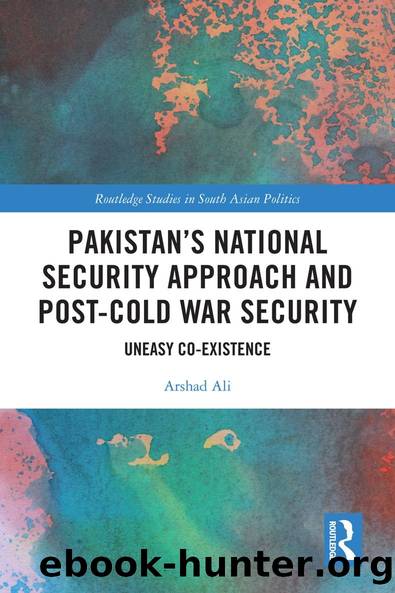Pakistan's National Security Approach and Post-Cold War Security by Arshad Ali

Author:Arshad Ali [Ali, Arshad]
Language: eng
Format: epub
Tags: Social Science, Ethnic Studies, General, Regional Studies
ISBN: 9780367709785
Google: SqkDzgEACAAJ
Barnesnoble:
Goodreads: 55783446
Publisher: Routledge
Published: 2021-01-15T03:29:46+00:00
The 1999 Kargil War in Kashmir
A war in Kargil was part of the Pakistani military strategy prior to 1999 but its implementation had been rejected by both political and military leaders on all previous occasions. Initially, it was discussed during General Ziaâs regime, but Zia rejected the proposal as it risked leading to full-scale war with India. Later it was reconsidered but shut down on the same grounds, and it was reported that the proposal could only be implemented when Pakistan was ready for a full-scale war (Abbas 2004). In July 1996, the then Lieutenant-General Musharraf once again forwarded this proposal to Prime Minister Bhutto, at GHQ, Rawalpindi, in his briefing regarding the military plan to wrest Kashmir from India. He tried to convince Bhutto that Pakistan needed to take action in Kashmir before it became too late. General Musharraf explained to Bhutto that the âtime window for the resolution of the Kashmir dispute is short, because with passage of time, the India-Pakistan equation in both military and economic dimensions is going against Pakistan.â He further warned that âthe differential is increasing and the window will closeâ (Paul 2014, 53). After the briefing, Bhutto had a detailed conversation with General Musharraf about the military solution of the Kashmir conflict, which she recounted in her autobiography (2008, 418â419):
Musharraf concluded the briefing with the words that a ceasefire would be in place and Pakistan would be in control of Srinagar â the capital of Indian-held Kashmir. I asked him, âAnd what next?â He was surprised by my question and said, âNext we will put the flag of Pakistan on the Srinagar Parliament.â âAnd what next?â I asked the general. âNext you will go to the United Nations and tell them that Srinagar is in Pakistanâs control.â âAnd what next?â I pushed on. I could see General Musharraf had not been prepared for this grilling and was getting flustered. He said, âAnd ⦠and you will tell them to change the map of the world taking into consideration the new geographical realities.â âAnd do you know what the United Nations will tell me?â I looked General Musharraf straight in the eye, as the army chief sat silently by and the room grew still, and pointedly said, âThey will pass a Security Council Resolution condemning us and demanding that we unilaterally withdraw from Srinagar, and we will have got nothing for our efforts but humiliation and isolation.â I then abruptly concluded the meeting.
So Bhutto also refused to support the Kargil plan to take military action in Kashmir. Thus, both military and civilian leaders concluded this plan could not serve their strategic objectives to wrest Kashmir from India.
Despite this context, General Musharraf had not given up his plan to launch a military offensive in Kashmir and was looking for an opportunity. Ultimately Musharraf started the Kargil War to occupy the Kargil heights in order to give a strategic advantage to the Pakistani military. Like the 1990 Kashmir crisis, the Kargil military conflict occurred when both
Download
This site does not store any files on its server. We only index and link to content provided by other sites. Please contact the content providers to delete copyright contents if any and email us, we'll remove relevant links or contents immediately.
Spell It Out by David Crystal(35849)
Life for Me Ain't Been No Crystal Stair by Susan Sheehan(35537)
Cecilia; Or, Memoirs of an Heiress — Volume 1 by Fanny Burney(32064)
Cecilia; Or, Memoirs of an Heiress — Volume 3 by Fanny Burney(31459)
Cecilia; Or, Memoirs of an Heiress — Volume 2 by Fanny Burney(31409)
The Great Music City by Andrea Baker(30784)
Professional Troublemaker by Luvvie Ajayi Jones(29424)
We're Going to Need More Wine by Gabrielle Union(18636)
Twilight of the Idols With the Antichrist and Ecce Homo by Friedrich Nietzsche(18303)
The Secret History by Donna Tartt(18170)
Cat's cradle by Kurt Vonnegut(14764)
All the Missing Girls by Megan Miranda(14750)
Pimp by Iceberg Slim(13782)
Bombshells: Glamour Girls of a Lifetime by Sullivan Steve(13689)
Fifty Shades Freed by E L James(12918)
Talking to Strangers by Malcolm Gladwell(12882)
Norse Mythology by Gaiman Neil(12836)
The Social Justice Warrior Handbook by Lisa De Pasquale(11956)
Underground: A Human History of the Worlds Beneath Our Feet by Will Hunt(11840)
